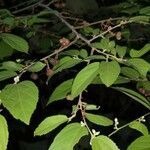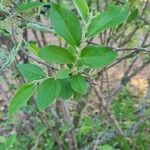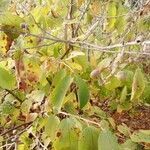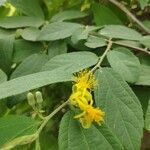Shrub or scandent tree to 7.5 m tall; young stems densely roughly to softly pubescent, often flattened, older branches 3–4-angled, grey-brown.. Leaves broadlyelliptic, ovate, oblong, obovate or almost circular, 4.5–14.5 cm long, 2–11 cm wide, obtuse, acute or acuminate at the apex, rounded, truncate or slightly cordate at the base, usually scabrid above, roughly to softly densely pubescent beneath, sometimes ± tomentose; petiole 3–12 mm long; stipules 9–10 mm long.. Inflorescence a 1–3-flowered cyme, 1–4 congested in a leaf-axil; peduncle 3–9 mm long; pedicels 5–14 mm long.. Flowers yellow; sepals 7–22 mm long, green to reddish brown on the outside, yellow to orange inside; petals 8–15 mm long, yellow.. Androgynophore 1–2 mm long, glabrous.. Stamens 8–18 mm long, yellow.. Ovary ± 3 mm long; style 4–17 mm long, yellow, hairy.. Fruit shallowly or obscurely 1–3(–4)-lobed, 8–10 mm long, 7–14 mm wide, sparsely stellate-pubescent to glabrescent and shiny, green becoming orange to reddish brown, later brownish black.. Fig. 3/24 (leaf, p. 9).
A small tree which loses its leaves during the year. It can grow 3-5 m tall. The crown is rounded. It can be a woody climber. It sometimes forms thickets. The stems are angular and form loops. Young branches are hairy. The leaves are oval and 10 cm long by 5 cm wide. There are coarse teeth along the edge and both sides of the leaves are hairy. The tips are pointed. The flowers are bright orange-yellow and star shaped with 5 slender gold petals. They occur in small bunches in the axils of leaves. The fruit are round and 12 mm across. The have slight lobes. They have very small hairs. They become yellow to red. They occur in groups of 4. They are edible.
Leaf-lamina 4–12 × 2–8·5 cm., oblanceolate, obovate or oblong-lanceolate, occasionally almost circular, acute or acuminate at the apex, margins irregularly serrate, rounded or subcordate at the base, harshly pubescent, particularly below; petiole up to 7 mm. long but usually shorter, pilose; stipules up to 1 cm. long, subulate to oblong-lanceolate, somewhat keeled, pubescent on both sides.
Fruit 8–14 × 13–15 mm., depressed-globose, sometimes entire but usually shallowly 2-or occasionally 4-lobed, yellowish-brown with short, appressed-stellate hairs often mixed with longer stellate hairs, somewhat shining when ripe.
Inflorescences all axillary on pubescent peduncles up to 1·5 cm. long; pedicels up to 2 cm. long, 2–3 per peduncle, pubescent; bracts entire, c. 3 mm. long, lanceolate to ovate-lanceolate, pubescent, especially on the back.
Shrub 2–5 m. tall; young branches stellate-pubescent, becoming glabrous; older stems 4-angled and somewhat sulcate, sometimes scandent.
Petals yellow, 6–8 × 1·5 mm., narrowly oblong, with a nectariferous claw villous on the margins within and at the base outside.
Ovary closely setose-pubescent, entire or slightly 2-lobed; style c. 1 cm. long, glabrous; stigma-lobes usually 4, subulate.
Flower-buds oblong with a slight swelling and then a constriction just above the base.
Sepals yellow inside, yellowish-tomentose outside, 12–20 mm. long, lorate.
Androgynophore 1·5–2 mm. long, glabrous, not elongated above the node.
Ripe fruits brown.
A savannah shrub
Flowers yellow





